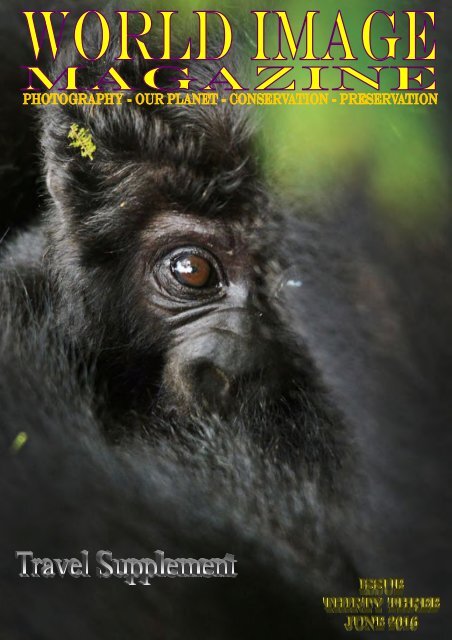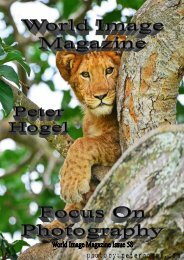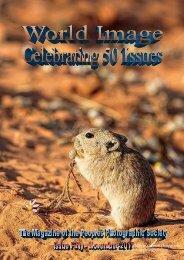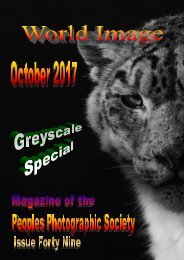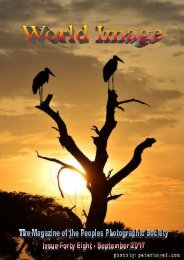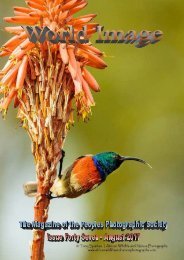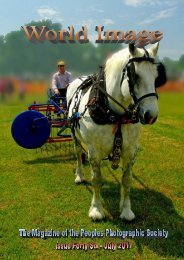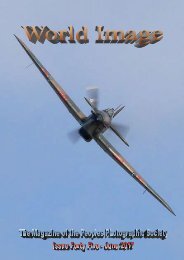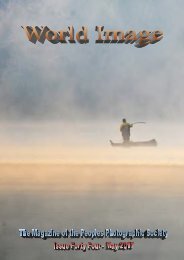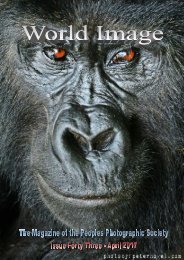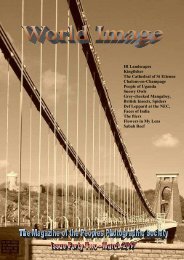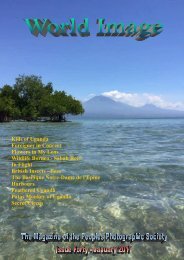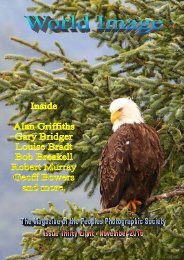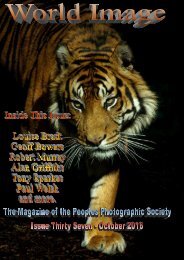You also want an ePaper? Increase the reach of your titles
YUMPU automatically turns print PDFs into web optimized ePapers that Google loves.
Website = photosociety.net Page 1 email = magazine@photosociety.net
Gordon Longmead - England - CEO<br />
Peter Hogel - Uganda - Deputy CEO<br />
Scott Hurd - Namibia<br />
Tom Coetzee - South Africa<br />
Paul Welch—Australia<br />
Contents:<br />
National and Regional Management<br />
3 Open Letter<br />
4 In Close Proximity - Bwindi by Peter Hogel<br />
8 Long Exposure Competition - Results for May<br />
10 The Netherlands - The Ardennes by Paul Weijenberg<br />
14 Water, Water Everywhere - Pictures by Alan Griffiths<br />
17 Tucson Rodeo Parade by Georgene Bergstrom<br />
21 A Sting in the Tail Pictures by Tom Coetzee<br />
22 Babies of the Night by Tony Sparkes<br />
23 Cholla Flower by Georgene Bergstrom<br />
24 War Eagle Cavern, Bever Lake by Louise Bradt<br />
32 Wild Horses of Namibia by Judy and Scott Hurd<br />
34 Wildlife of Borneo, Sabah Reef by Gary Bridger<br />
36 A Study in Greyscale - IR Landscapes by Alan Griffiths<br />
39 Wild Africa by Tony Sparkes<br />
41 Picture Spot - Tigers by Mike Shawcross<br />
42 Stevenage, A Town I Once Called Home by Gordon Longmead<br />
53 A Time to Spend the Time - Gordon Longmead<br />
54 Common Reptiles of the Southern Kruger by Ian Bales-Smith<br />
58 A Study in Nature - Kestrel by Scott Latham<br />
60 A Study in Architecture - Waterfront Homes by Louise Bradt<br />
62 Birds of a Feather<br />
64 Bringing Rhinos Back to Uganda, Ziwa Rhino Foundation<br />
68 Study in Flight by Scott Latham<br />
69 Photo Spot - Actress Jessica Messenger by Mike Shawcross<br />
70 Travel Supplement.<br />
Steve Cook - USA<br />
Robert Murray - Scotland<br />
Tina Andreasson - Sweden and Mexico<br />
Jack Glisson - Kentucky USA<br />
Rodger Lee - Steam Punk Events<br />
<strong>World</strong> <strong>Image</strong> Magazine on Fine Art America<br />
Peoples Photographic Society Member galleries<br />
http://gordon-longmead.artistwebsites.com/index.html?tab=galleries<br />
As part of the expansion and ongoing development of the <strong>World</strong><br />
<strong>Image</strong> Magazine, we have established a website presence within Fine<br />
Art America for the presentation and promotion, and sale of member<br />
images.<br />
Members wishing to add their own gallery should contact Gordon@worldimagemag.co.uk for<br />
details.<br />
© Please remember that all articles and images published in this magazine are copyright protected<br />
Cover picture - Bwindi Gorilla by Peter Hogel<br />
Website = photosociety.net Page 2 email = magazine@photosociety.net
With less than 12 weeks before the decision deadline, the time has finally come to notify the many<br />
loyal advertisers and readers of the current situation regarding this free magazine. The following is<br />
a copy of an open letter that was issued on the 14th May <strong>2016</strong>.<br />
Dear Sir’s,<br />
The <strong>World</strong> <strong>Image</strong> Magazine is now fast approaching the end of its third year of successful<br />
publication. This milestone will take place with the publication of the September <strong>2016</strong> issue of the<br />
magazine. This coincides with the renewal date for the website that holds the magazine on-line, and<br />
the final issue in which all current advertising arrangements will come to an end.<br />
This brings me to the reason for this letter. The magazine and its work was originally supported by<br />
private funding and paid advertising. For the continuation of the magazine, we are again seeking<br />
advertising support. The rates are not expensive as the magazine is non-profit, we seek only<br />
sufficient funding to continue publishing. While there are other costs associated with the magazine,<br />
the most immediate is our web hosting package which is due for renewal in August, the future<br />
continuation and coverage of the magazine will depend entirely on the amount of advertising and<br />
support we receive.<br />
Site statistics show that in 2015 our website received 18,839 visitors reading 261640 pages, an<br />
average of 3087 readers each month indicating that the unique readers are returning for further<br />
reading. Thus far in <strong>2016</strong> this full colour magazine has enjoyed highs approaching (and surpassing)<br />
4000 readers. The magazine itself has be revamped and has recently been made available via a<br />
number of on-line sources such as <strong>Issue</strong> and Joomag, this also allows access to the magazine via<br />
mobile devices.<br />
At the present time we do not pay for articles, we want people to write for us who are passionate<br />
about their photography and not writing for greed. We also wish to avoid those photographers<br />
claiming the work of others as their own as has recently been the case with many ‘known’<br />
professionals. The flip side to this approach is that we have a magazine that is free to anyone who<br />
wishes to become a part of the <strong>World</strong> <strong>Image</strong> family.<br />
Currently quarter and half page adverts are included in a section to the rear of the magazine, but<br />
these may also be copied anywhere within the magazine to suit editorial requirements. The cost for<br />
advertising is £5 per quarter page per issue, or £50 (GBP) per quarter page for 12 issues. Please<br />
contact Gordon by email at the address below for information.<br />
As CEO and Editor in Chief of the Society and Magazine, I would like to thank all those companies<br />
who have supported and funded us in the last three years. This has truly been a great experience.<br />
Yours Sincerely<br />
Gordon Longmead<br />
lendasnow@hotmail.co.uk<br />
Website = photosociety.net Page 3 email = magazine@photosociety.net
Close up with the family, in two ways…<br />
We are close relatives with the Mountain Gorillas, I’d like to see<br />
them as our better half, not destroying the world around them…<br />
also this time close to their new family members…<br />
The Rushegura family in Buhoma, Bwindis Impenetrable Rain<br />
Forest in Uganda has two newborns.<br />
Tracking Mountain Gorillas are always a thrill, I’ve been<br />
doing it a few times, guiding tours in Uganda, and every<br />
time is as exiting, the dense rainforest, spectacular view<br />
over the mountains and finally to meet the relatives…it<br />
never gets old!<br />
This time, was a treat<br />
above ordinary, we knew the<br />
Rushegura family have two new born, and after<br />
a short walk, not even an hour there the family was.<br />
We approached the family and found ourselves a few meters<br />
from two females and their two month old babies, and a big<br />
brother, and for almost the entire hour we could just sit and<br />
watch, very close, the family life of the mountain gorilla, the<br />
silverback just behind our backs, keeping an eye…keeping<br />
everyone in order…us included.<br />
The Rangers guarding and caring for the gorillas, are doing an<br />
awesome job, both directly with us visitors, guiding and<br />
educating, also monitoring the gorillas, reporting to the<br />
“gorilla doctors” if help is needed.<br />
Website = photosociety.net Page 4 email = magazine@photosociety.net
Gorillas do self-medicate, on the menu are some 57 species of plants some eaten to<br />
treat upset stomachs or for de-worming purposes.<br />
The Rangers also fight a war against poachers, they<br />
are still hunted for souvenirs or meat, It is a<br />
dangerous war and rangers do pay with their<br />
life. And I wish to pay my respect and gratitude<br />
to all those involved in protecting the last<br />
survivors, around 800 Mountain Gorillas!<br />
So, I am a photographer, and it is a photo<br />
magazine…so, from a photographers point of<br />
view…<br />
Dense, humid,<br />
wet, dark and<br />
muddy rain<br />
forest, whatever<br />
can go wrong?<br />
Well its not as bad as it sounds, but one should be prepared…<br />
Equipment, Me I’m using a Nikon d800, I like to bring my 24-300,<br />
you do get close, so to be able to take full body shots you need that<br />
bit of a wider angle, however I do like those nice close ups so I also<br />
bring my 150-500.<br />
You might be up for a long walk up the<br />
mountains so you don’t want to be carrying<br />
around to much…porters are available … but<br />
also, sitting in that dense forest vegetation<br />
keeping equipment to a minimum is<br />
preferable, you just don’t sit there changing<br />
lenses more than necessary.<br />
Website = photosociety.net Page 5 email = magazine@photosociety.net
Due to the dense “under vegetation” its also tricky to<br />
use a tripod, monopod would be preferable, but I<br />
usually end up handholding or using whatever trees are<br />
around, monopods should also be used carefully…<br />
Gorillas do use sticks when showing of and scaring of<br />
others, and you don’t want that silverback thinking<br />
you are up for challenging his territory with your<br />
stick…you will end up on the short end!<br />
So, challenges…Gorillas like the dense forest, so vegetation is<br />
often a factor…being in the way, so getting clear shots can be a<br />
trick, also, the rainforest often shades the light from breaking<br />
through, ending you up with rather high ISO, I usually manage to<br />
keep it at about 1200, but sometimes you do get lucky, and they<br />
are just there in the open…<br />
I do run tours here in Uganda, if you<br />
are interested, please contact me, we<br />
are not all about gorillas, we have<br />
chimpanzees and a number of<br />
smaller primates, one of the best<br />
Birding locations in the world. And<br />
of course, elephants, rhinos, hippos,<br />
crocs, giraffes, zebras, antelopes …<br />
lions and leopards and so much<br />
more…welcome to Uganda<br />
Peter Hogel , Eden Adventures.<br />
Website = photosociety.net Page 6 email = magazine@photosociety.net
So … You going to come visit?<br />
Website = photosociety.net Page 7 email = magazine@photosociety.net
1st - Alan Griffiths - I love long exposure photography , I also do a lot of mono / infrared<br />
( 720n filter ) so today I tried a infrared long exposure , a converted camera ( 720n<br />
infrared ) iso 100 , 30 sec, and the new cokin nuance 8 stop nd filter .<br />
3rd - Matt Co<br />
<strong>June</strong> Competitio<br />
“As A<br />
Website = photosociety.net Page 8 email = magazine@photosociety.net
2nd - Peter Hogel - Fire Man<br />
4th - Geoff Bowers - Night Rose<br />
llins - Motorway Madness<br />
Website = photosociety.net Page 9 email = magazine@photosociety.net
The Netherlands<br />
Ardennes, part 4, all kinds of everything.<br />
Paul Weijenberg<br />
Les Ardennes Bleue it is called, the wet parts of the<br />
Ardennes.<br />
Early morning is the best time for walks: the paths<br />
are not busy, the light is fabulous.<br />
There is a restriction however: the animals need<br />
their rest, you may start you trip after 06:00 hours.<br />
That's early enough, it's a drive of about half an hour<br />
up there for me.<br />
This is very much a living and changing<br />
environment, the fragile parts are often hidden deep<br />
in the forests.<br />
It's imperative to stay on the path. In this out of the<br />
world terrain it is also good advice, you cannot walk<br />
over this vegetation.<br />
Website = photosociety.net Page 10 email = magazine@photosociety.net
You will soon be bogged down literally.<br />
This land was divided in the past. It is littered with<br />
border stones from all kinds of royalty. This is from<br />
Butgenbach, the year: 1595.<br />
This is the part where large forests are cut down (see<br />
previous article) to bring more water to the streams<br />
and fresh water lakes.<br />
Website = photosociety.net Page 11 email = magazine@photosociety.net
The part chalk, part sandy grounds and part acid<br />
grounds or the soils that contains iron, they all<br />
contribute to a strange vegetation, plants that are<br />
rare elsewhere.<br />
Fall has it's own special colours. This is a road in<br />
Membach.<br />
Iron is abundant! Layered formations are<br />
everywhere.<br />
Website = photosociety.net Page 12 email = magazine@photosociety.net
All around you there's decay and growth, nature left<br />
to itself in the Ardennes<br />
This area is geologically interesting, all kinds of<br />
strange things are to be found. Look at the size of<br />
these rocks, observe the trees at the top. You finds<br />
this along the Statte, Rocher de Bilisse, near the<br />
town Solwaster.<br />
This corner (Neur Lowe) lies outside the main route<br />
to the much visited Cascade du Bayehon.<br />
Undisturbed and not too moist, this led to a variety<br />
in vegetation.<br />
This concludes our wanderings through the<br />
Ardennes, I hope you enjoyed it and I hope that you<br />
are able to visit here for yourself to enjoy it even<br />
more.<br />
Paul.<br />
Website = photosociety.net Page 13 email = magazine@photosociety.net
Water Water Everywhere<br />
Pictures by Alan Griffiths<br />
When it comes to photographing scenes containing expanses of water, it is so easy to try to<br />
get it all in the frame. Of course there is nothing wrong with that, we<br />
use the technique all the time when photographing<br />
seascapes and landscapes … or<br />
do we?<br />
So we visit the seaside and take the picture of<br />
the sea, split through the middle, sea and sky, we may even show<br />
the sandy beach or cliffs to one side if we think of it, or even a boat. But there is more<br />
to water than an expanse of ripples reflecting the overcast sky.<br />
A little thought and even the normal form of seascape we take can be set apart from those ‘holiday snaps’<br />
we often see. In this picture Alan has use height to take the picture and concentrated on the shoreline. Even<br />
though the sky is full of detail, this has been ignored in favour of the lighting and structure of the beach.<br />
These simple changes to viewpoint<br />
and framing have raised the image<br />
away from the ordinary.<br />
While on the beach it is also worth<br />
remembering that if you can see<br />
across the bay, then you can be<br />
seen from there as well.<br />
Look behind you and if the scene<br />
is worth taking it is also worth<br />
walking to the opposite side of<br />
the bay to get the picture.<br />
Here the calm waters provide the reflections while the<br />
sky provides a stunning backdrop to the main subject.<br />
Website = photosociety.net Page 14 email = magazine@photosociety.net
If you are facing the right way either east<br />
at sunrise or west at sunset, the view of<br />
the seascape changes with the light of the<br />
rising or setting sun.<br />
In these images the sky is of less<br />
importance than the lighting and the<br />
elements in the scene.<br />
We all seem to like a good red sunset, but<br />
these happen only occasionally. These<br />
need the clouds to be in the right place at<br />
the right time, and more often than not<br />
they move away and a promising start<br />
fades to nothing above the water line.<br />
But good foresight and positioning can<br />
still pay dividends, the sea will reflect an<br />
extended image of the sun and the dying<br />
rays of the evening may still illuminate<br />
the structures of the shoreline.<br />
Always keep in mind that here again<br />
height plays a part, the higher you are the<br />
later the sun will set and disappear giving<br />
more opportunity to catch the effects of<br />
the changing light.<br />
In the many pictures seen of both of these events, there<br />
has been one general format that has almost become an<br />
unwritten habit with photographers.<br />
When we see images of sunsets the sun is invariably<br />
setting to the right of the picture, while the sunrise<br />
images has the sun rising to the left of the frame.<br />
There are those odd days when the sun refuses to show<br />
during our visits to the coast. How many times do we<br />
find it is dark overcast and raining, and think “not<br />
much point taking the camera out”.<br />
There is a point, and this picture demonstrates the<br />
reason why. Dull overcast days (also ND filters), allow<br />
us to use very slow shutter speeds to capture the<br />
flowing water as it hits the beach.<br />
These can be effective in colour, but if you have the<br />
right structural elements in the frame, try converting to<br />
greyscale. Not everything will work, but if you do not<br />
try you will never discover.<br />
Website = photosociety.net Page 15 email = magazine@photosociety.net
Staying with those dull overcast<br />
days, you do not have to be at the<br />
seaside to use the slow shutter<br />
speeds to get the effects.<br />
This image of the Drain Hole in<br />
Ladybower Reservoir shows the<br />
flowing of the water, not just in<br />
the overflow, but also in the lake<br />
surface that surrounds it.<br />
This type of movement is found<br />
everywhere where there is water,<br />
from the household tap (faucet if<br />
you like), to rivers and waterfalls,<br />
to rain, lakes and the seas.<br />
One of the things we often take<br />
for granted is the natural, and not<br />
so natural, structures that are<br />
round about us.<br />
We see the pier but not the<br />
breakwaters. We see the cliffs but<br />
not the rocks. It is the old saying<br />
of not seeing the wood for the<br />
trees, and yet if we see the wood we can see much more to take pictures of. The basic rule with<br />
any structure or line in a picture is that it should never lead the eye out of the<br />
frame.<br />
In this final image the eye is drawn back to the<br />
centre of the frame while the reflected<br />
light adds interest to the<br />
jetty.<br />
Website = photosociety.net Page 16 email = magazine@photosociety.net
Tucson Rodeo Parade<br />
Georgene Bergstrom<br />
I always wanted to be a cowgirl. So when I stepped<br />
off that train into the hot desert air, saw the<br />
mountains and the 20 foot high saguaro cacti, I felt<br />
like I had come home.<br />
The Rodeo Parade was about to kick off the annual<br />
9 day Fiesta de los Vaqueros (Spanish for<br />
“Celebration of the Cowboys”).<br />
Arizona had everything – crystal blue skies,<br />
blooming cacti, occasional lightning-infused<br />
thunderstorms & rainbows, fabulous sunsets, the<br />
Grand Canyon and…….a RODEO!<br />
The Thursday morning dawned clear and hot in mid-<br />
February. It was going to be a huge day for all of<br />
Tucson’s residents.<br />
Started in 1925, the rodeo and parade is steeped in<br />
Western tradition. Schools are closed for two days<br />
and people come from all around Arizona and<br />
beyond to enjoy a day with friends & family.<br />
The Tucson Rodeo Parade is said to be the longest<br />
non-motorized parade in the world. It is filled with<br />
horses of all types, sizes and colours.<br />
Website = photosociety.net Page 17 email = magazine@photosociety.net
Website = photosociety.net Page 18 email = magazine@photosociety.net
Website = photosociety.net Page 19 email = magazine@photosociety.net
Riders in western garb, buffalo soldiers, horsedrawn<br />
carriages, floats, buggies and marching and<br />
mariachi bands abound.<br />
There is also an organization called “Cactus<br />
Cowboys” where youngsters can learn skills with<br />
lariats.<br />
Upwards of 200,000 people of all sizes, shapes &<br />
ages line the streets, dressed in cowboy hats, jeans<br />
& boots, sandals & shorts or odd combinations of<br />
whatever came out of their closets.<br />
If you are interested in doing Street Photography,<br />
there’s nothing more fun than a parade to get the<br />
juices flowing.<br />
The Tucson Rodeo itself is a time-honoured sport. It<br />
boasts the fact that it is the only sport that is derived<br />
from actual work experience.<br />
Georgene Bergstrom<br />
These cowboys & cowgirls begin at an early age to<br />
learn the skills that will start them on a life-long<br />
journey in the saddle. This is evidenced by an event<br />
for 4-6 year olds, called “Mutton Bustin” where they<br />
ride sheep for prizes.<br />
Website = photosociety.net Page 20 email = magazine@photosociety.net
A Sting in the Tail -Burrowing Scorpion taken with iPhone<br />
by Tom Coetzee<br />
Website = photosociety.net Page 21 email = magazine@photosociety.net
Babies of the Night.<br />
Tony Sparkes<br />
Babies of the night. Lesser Bushbaby (Galago moholi) In South Africa in Afrikaans they are called<br />
'Nagapies/Nagaap' or 'little night monkey' which I think is a great name. these are one of two species of<br />
bushbaby found in South Africa, the other being the Thick-tailed Bushbaby (Otolemur crassicaudatus)<br />
which is much larger, although both nocturnal. These I caught popping their heads out of the tree close to<br />
where we lived in South Africa.<br />
Tony Sparkes<br />
Website = photosociety.net Page 22 email = magazine@photosociety.net
Cholla Cactus Flower<br />
Georgene Bergstrom<br />
The Cholla cactus represents over twenty species of the Opuntia genus (Family Cactacea) found in the<br />
North American deserts. Cholla cactus are found in all of the hot deserts of the American Southwest, with<br />
different species having adapted to different ranges.<br />
Most require coarse, well-drained soil in dry, rocky flats or slopes. Some have adapted to mountain forests,<br />
while others require steep, rocky slopes in mountain foothills.<br />
Prickly pears are also members of the Opuntia genus, but their branches are pads rather than cylindrical<br />
joints. Although found in other cactus, the Opuntia are unique in that they have clusters of fine, tiny, barbed<br />
spines called glochids found at the base of regular spines, these are yellow or red in colour and are difficult<br />
to see and remove once lodged in the skin.<br />
Those of us who have grown these in the greenhouse will be aware that the barbed glochids can be ‘fired’ at<br />
a passing hand, especially if the person is unknown, well that is the way it appears, the spines are designed<br />
so that they land on the skin and cause irritation.<br />
They get embedded when we try to brush them away, so don’t. The best way of removing them is to wash<br />
them off under running water but do not try to wipe them off. Embedded spines are easiest to remove using<br />
glass paper (sandpaper).<br />
Website = photosociety.net Page 23 email = magazine@photosociety.net
Lake Facts<br />
Beaver Lake is a manmade lake<br />
that was built by the Army<br />
Corps of Engineers.<br />
Work began on building the<br />
Beaver Dam across White River<br />
in 1964 & was completed in<br />
1966. It then took another two<br />
years for the flooding to be<br />
complete &the lake to be<br />
formed.<br />
War Eagle Cavern – “a little<br />
gem hidden in the woods”<br />
Let’s be honest here, when people talk about places to visit in the U.S,<br />
Arkansas probably isn’t on many peoples Top 10 list! When my parents<br />
flew out here for the first time they came through customs in Atlanta and<br />
the Customs Officer actually said to them “Arkansas? Why on earth<br />
would you be going there?” Well, I am perfectly O.K with that, and I am<br />
sure that most people who live here are too, because that means that this<br />
wonderful unspoilt gem, known as ‘The Natural State’ has more chance<br />
of staying that way – Natural and wonderful.<br />
In actual fact Arkansas has lots going for it, especially here in the NW of<br />
the state where we have the Ozarks, a mountain range that was thrust up<br />
out of what was once an ocean about 350 million years ago! Because this<br />
area was once covered by water, this area is all sedimentary rock and here<br />
at Beaver Lake that rock is predominantly Limestone. So when the<br />
Ozarks were formed, all those millions of years ago, as the rocks were<br />
pushed up, many caverns were formed, some small, some bigger and<br />
some a lot bigger like War Eagle Cavern.<br />
<br />
The lake has approx. 472 miles<br />
of coastline depending on how<br />
close to full pool level it is. Full<br />
pool is 1130ft<br />
At it deepest the lake is 250–<br />
300 ft deep.<br />
The lake looks like a giant<br />
octopus when you look at it on<br />
a map.<br />
<br />
<br />
20% of the drinking water for<br />
NW Arkansas comes from<br />
Beaver Lake.<br />
Thousands of people come to<br />
spend their summer holiday on<br />
Beaver Lake every year.<br />
Website = photosociety.net Page 24 email = magazine@photosociety.net
About the Cavern<br />
War Eagle Cavern is situated on the south side of<br />
Beaver Lake just off Hwy 12 about halfway<br />
between Rogers and Eureka Springs.<br />
It sits nestled in the woods with the lake on one<br />
side and the Hobbs State Park on the other in a<br />
region know to locals as the Piney Point Area.<br />
Once you turn into the cavern driveway there<br />
are signs telling you that you are entering a<br />
media no mans land. There is no cell signal and<br />
no internet – the advice is to accept that you are<br />
unplugged from the rest of the world and just<br />
enjoy the nature around you!<br />
It is beautiful unspoilt countryside that is home<br />
to some wonderful wildlife in the form of Bald<br />
Eagle, Turkey Vulture, Red-tailed Hawk, Whitetailed<br />
Deer, Gray & Red Fox, Bobcat, Raccoon,<br />
Armadillo (yes you did read that right!),<br />
Opossum, Skunk, Coyote, Black Bear and even<br />
the odd Mountain Lion or two, to name but a few<br />
of the more recognizable; as well as some<br />
beautiful and lush vegetation like Red & White<br />
Oak, Sassafras, Short-leaf & Lob-lolly Pine,<br />
Cedar, Black Walnut, Birch, Sweetgum, Hickory,<br />
Dogwood, Sumac & Elm.<br />
The cavern is open from mid-March (when our<br />
bats start to come out of hibernation) until the<br />
beginning of November (when hibernation starts<br />
again), and it is open 7 days a week, with guided<br />
tours every 20 minutes during busiest times. If<br />
you are keen to see lots of bats you really need<br />
to come early or late in the season since by the<br />
end of July the bats will have left the cave for<br />
the summer and won’t return until the weather<br />
starts to get cooler and they begin to prepare for<br />
hibernation.<br />
As well as tours of the Cavern, there are Nature<br />
Trails to explore and a Maze to lose yourself in,<br />
or you can pan for gems in our mining sluice.<br />
There is also a great gift store full of cavern and<br />
nature themed gifts for you to take home for<br />
family and friends.<br />
Website = photosociety.net Page 25 email = magazine@photosociety.net
More about the Cavern<br />
War Eagle Cavern has always been a privately<br />
owned cavern and it was first opened to the public in<br />
1977,when the Wallace family owned it. The current<br />
owners, the Boyers bought the Cavern and grounds<br />
about 20 years ago and it is a real labor of love for<br />
them, both of them working each day alongside their<br />
other staff to ensure that all visitors have a<br />
wonderful experience when they visit.<br />
The cave has a very long and documented history<br />
though, going back long before 1977. It would have<br />
first been used by the Osage and Cherokee Indians<br />
who we know used to come to the Ozarks to hunt<br />
deer, bear, mountain lion and in those days wolves.<br />
When the early settlers moved in, they undoubtedly<br />
found and used the cave too. Arkansas was<br />
originally settled by the French and this is where the<br />
name for the mountain range ‘The Ozarks’ came<br />
from. The French would call the area ‘Aux<br />
Arkansas’ or ‘Aux Ark’ for short. The none French<br />
speakers in the area unable to get the French<br />
pronunciation right said ‘Ozark’ and it stuck!<br />
During the Great Depression we know that a family<br />
used one of the rooms just inside the entrance to the<br />
cavern, and lived there for several years having lost<br />
everything they had. They even went so far as to put<br />
a mailbox up on what would have been the highway<br />
at the time!<br />
This area of NW Arkansas is also extremely famous<br />
for the outlaws Frank & Jesse James and the James<br />
Younger Gang. The James brothers had family who<br />
lived just a few miles down the road in an area<br />
called Clifty, and also an Uncle who owned a<br />
hardware store in nearby Eureka Springs. It is<br />
known that the gang would come and hide out in the<br />
cavern while the brothers visited family, and the<br />
whole gang would resupply from the Uncles<br />
hardware store. The movie ‘Frank & Jesse’ starring<br />
Rob Lowe and Bill Paxton was filmed entirely in<br />
this area of Arkansas with scenes shot in War Eagle<br />
Cavern as well since it known the gang used the<br />
cave.<br />
As well as outlaws, our cave is famous for<br />
moonshine, but it’s probably best not to talk about<br />
that too much!<br />
Website = photosociety.net Page 26 email = magazine@photosociety.net
So what about Bats?<br />
The Cavern is home to approx. 75,000 Eastern Pipistrelle and Gray Bats. NW Arkansas is about on the limits<br />
of the Eastern Pipistrelles range, and the Pipistrelle is a tiny little yellowish brown bat that in adulthood is<br />
about the size of your thumb. They have a wingspan of 7-8 inches so when they are in flight they look a lot<br />
bigger than they really are. The Pipistrelle is not a colony bat so when you see them hanging in the cavern they<br />
are always dotted about rather than in big clumps. They are quite inquisitive and they have pretty good<br />
eyesight, contrary to what we are all taught about being ‘blind as a bat’, and they like to fly pretty close to<br />
visitors in the cavern to ‘check them out’.<br />
The Pipistrelles breed in late August/October, but the females are able to hold onto the sperm through<br />
hibernation, and fertilization and pregnancy takes place in the Spring with one or two pups being born at the<br />
end of May or beginning of <strong>June</strong>. The male Pipistrelles don’t hang around after hibernation and quickly head<br />
out into the surrounding woodland leaving the females to work together raising the young pups. During this<br />
time the females will tend to hang together so that they can help each other with the pups and be able to get out<br />
and feed as well. By the end of July all of the pups are weaned and are expert fliers, and so all the young and<br />
females leave the cavern for the summer and don’t really return until the end of the fall when it starts to get<br />
cooler and they prepare for hibernation. While they are out in the woodland the females and young usually<br />
group together in numbers of approx. 15, this helps the females keep an eye on their young through this first<br />
summer period. The males do not group together at all preferring to spend their time in the woods as solo bats.<br />
The other bat in the cavern is the Gray bat, which is actually an Endangered Species. They are approx. 4 times<br />
bigger than the Eastern Pipistrelle’s and unlike the Pipistrelles, the Gray bats stay in the cavern year round.<br />
Gray bats are colony bats, meaning they like to group together in very large numbers, and it is for this very<br />
reason that they have become endangered - large numbers of them living in only a few caves. As a result, they<br />
are extremely vulnerable to disturbance. Arousing bats while they are hibernating can cause them to use up a<br />
lot of energy, which lowers their energy reserves. If a bat runs out of reserves, it may leave the cave too soon<br />
and die. In <strong>June</strong> and July, when flightless young are present, human disturbance can lead to deaths as<br />
frightened females drop their young in the panic to flee from the visitor. The Gray bats in War Eagle Cavern<br />
have made their home much further back in the cavern than the public tour will take you. Spelunker or Wild<br />
tours which take visitors further back into the cavern, do not begin until after all the young are weaned and<br />
flying which is usually by the end of July.<br />
Bats eat bugs and the Pipistrelles in particular love mosquitoes – each one consuming up to 5,000 a night. The<br />
Gray bats eat a variety of aquatic and terrestrial insects present along rivers or lakes.<br />
Website = photosociety.net Page 27 email = magazine@photosociety.net
More views of the Cavern & grounds<br />
Website = photosociety.net Page 28 email = magazine@photosociety.net
Guided Tours of the Cavern take approximately one hour and unlike many caverns, the tour<br />
starts up above the entrance to the cavern and takes down a pathway that winds down through<br />
the woodland with your Guide giving you a brief history of the area, of when and how the<br />
Ozarks were formed (be prepared for tales of Noahs Ark if Phil is your Guide), and also a history<br />
of Beaver Lake. As you meander down the hill you are actually walking over the cavern itself<br />
and you get a change to really appreciate the beauty of this area and all that it has to offer.<br />
If you are lucky you may get to see Mama Armadillo and her young, or Mama Gray Fox and her 3<br />
cubs which she has had this year and lives with in a smaller cave just above the entrance to the<br />
cavern. Wild flowers grow among the trees, and birdsong can be heard all around you. One<br />
thing you cannot do in Arkansas is be in a rush – there is no such thing as a ‘rush’ here. Life<br />
happens as life happens, people enjoy life, they sit long, talk often and enjoy the beauty of the<br />
world around them. People here live long and nature rich lives. It’s probably why so many of<br />
them say they are “older ‘n dirt”.<br />
You can find more information about War Eagle Cavern on Beaver Lake in NW Arkansas by<br />
visiting.<br />
https://www.facebook.com/WarEagleCavern/<br />
Or<br />
http://www.wareaglecavern.com<br />
Words and Photographs by Louise Bradt of Lou Bradt Photography<br />
Website = photosociety.net Page 29 email = magazine@photosociety.net
Generated <strong>Image</strong>s Can be Fun<br />
Next month we review LandscapePro by Anthropics<br />
To wet the appetite...<br />
Landscape Pro is a manipulation software from Anthropics ( www.anthropics.com ), makers of Protrait Pro,<br />
designed to take the effort out of image manipulation.<br />
In next months issue we will be reviewing the software from the point of view of someone who has never<br />
used it … me … I do things the ‘proper’ way which means learning to do the tasks using the tools in Adobe<br />
CS6 and discovering how they work for each change I wish to make.<br />
In post processing we learn by our mistakes, so it should be interesting to discover what the photographer<br />
can, or will, learn when using Landscape Pro.<br />
To give you a taster of what is to come, these images are part of the first group to be tried and will be<br />
discussed in the article..<br />
Website = photosociety.net Page 30 email = magazine@photosociety.net
Website = photosociety.net Page 31 email = magazine@photosociety.net
Wild Horses of Namibia<br />
Pictures by Judy and Scott Hurd<br />
In the last few magazines we<br />
have been exploring the world of<br />
the Namib Horses. The<br />
magazine tries to support certain<br />
charities and trusts, the Namib<br />
Horses is one of them.<br />
Having covered most of their<br />
story, we thought you may<br />
like to see some more images<br />
of these domestic horses<br />
turned wild.<br />
Abandoned and set free in<br />
the harsh, arid landscape of<br />
the Namibian Desert, these<br />
nomads have so far beaten<br />
the odds to survive.<br />
There are newborns in the herd that<br />
must learn to live in this<br />
environment where food is scarce<br />
and water even scarcer, especially<br />
in the dry season.<br />
The horses are protected and a<br />
licence is required to go and<br />
visit them in the wild, which<br />
is probably a good thing as<br />
there are only a few<br />
hundred of them in the herd.<br />
Although those looking after the<br />
horses do not interfere with this<br />
mini culture, money is used to<br />
provide such things as salt licks which<br />
enable the horses to survive the journeys between<br />
meals and watering places.<br />
Website = photosociety.net Page 32 email = magazine@photosociety.net
They kick, bite, mate and fight, They breed<br />
and feed, they are alive … they survive inspite<br />
of all the desert can throw at them.<br />
If you want to donate money to help<br />
them or our other projects please<br />
contact the magazine. We take no<br />
fees so every penny you donate<br />
goes where it should.<br />
Website = photosociety.net Page <strong>33</strong> email = magazine@photosociety.net
Wildlife Borneo - Another Day in Paradise 5<br />
Sabah Reef by Gary Bridger<br />
The underwater world of Sabah Reef is threatened by development and irresponsible tourism. Here is just a<br />
glimpse of the fragile beauty that may soon disappear.<br />
Website = photosociety.net Page 34 email = magazine@photosociety.net
Website = photosociety.net Page 35 email = magazine@photosociety.net
Toned G<br />
A Study in Greyscale - IR Landscapes<br />
Pictures by Alan Griffiths<br />
There is something about pictures taken<br />
in infra-red although many are not truly<br />
IR. They are in effect infra-red effect<br />
pictures, but this does not detract from<br />
the final pictures.<br />
IR is the recording of an image in the<br />
form of a heat map. The hotter the<br />
subject the whiter they appear in the<br />
image.<br />
You can convert the sensor in the<br />
camera to record the image as IR, but<br />
most settle for the digital conversion.<br />
Website = photosociety.net Page 36 email = magazine@photosociety.net
For the most part the viewer will be unable to tell the<br />
difference, and why would they want to?<br />
When we look at the world around us it is easy to assume that<br />
some items are hot therefore will be light in IR and others will<br />
be dark because they are cold.<br />
Those people who have installed night security cameras to<br />
watch over their gardens will certainly be surprised at the<br />
unexpected variation in the picture.<br />
We may expect that all plants would give off a similar amount<br />
of heat, no so, some plants appear very dark in IR while others,<br />
like the aubrietia are almost white with the radiated heat.<br />
Just because an image looks other worldly in infra-red, does<br />
not mean they must stay that way. Toning can change an image<br />
and create a new masterpiece. The most commonly used is the<br />
sepia tone, but there are many others, and even this can be<br />
adjusted to the subject.<br />
Website = photosociety.net Page 37 email = magazine@photosociety.net
The best subjects for the infra-red<br />
treatment tend to be trees and sunlit<br />
landscapes (but I could be wrong - feel<br />
free to prove this).<br />
In the main, the greens in the plants<br />
appear bright, as many shades appear in<br />
the leaves as there are shades of green.<br />
Each shade of green and brown radiates<br />
a different amount of heat and that in<br />
turn varies the picture.<br />
Expect the unexpected and remember<br />
that water is cold and so is the open sky.<br />
Sunlit landscapes are warm where the<br />
sun touches.<br />
Clouds you may expect to be cold are in<br />
fact hot. Read up on cloud<br />
temperatures and you will discover that<br />
some can be as much as 10,000 Kelvin.<br />
As a photographer you should know<br />
this as it is a major part of the visual<br />
training.<br />
Be prepared to experiment as it is only<br />
by trying that you will learn the skills<br />
necessary. Above all, enjoy.<br />
Website = photosociety.net Page 38 email = magazine@photosociety.net
Wild Africa by Tony Sparkes<br />
An 'Elephant Bull' I took coming out the water from the 'Sweni' river in the Kruger National Park - South Africa. I wasn't that<br />
happy with the colour version. I gave it a different post process, monochrome. The B&W version gives a lot more of a<br />
'contrasty' photograph which I think works better in this situation, as their was little contrast in the original colour version.<br />
Tony Sparkes<br />
Right: Here Kitty Kitty by Tony Sparkes<br />
Black & White of a female lion (Panthera leo) showing her<br />
canine's here, interestingly lions have three types of teeth, all are<br />
shown in the photograph<br />
1. The incisors, the smallest teeth at the front of the mouth, these<br />
are used for gripping and tearing of flesh.<br />
2. The canines, the four largest teeth (located either side of the<br />
incisors), can reach up to 70 millimetres (3in) in length. These<br />
are used to rip skin and tear away flesh.<br />
3. Carnassial, are the sharpest teeth at the back of the mouth,<br />
these act like a pair of scissors to cut flesh.<br />
Little bit of a fact: Lions can open their jaws to up 110mm (4in)<br />
wide, giving lions one of the animal kingdom’s biggest bites!<br />
Meow.....<br />
Website = photosociety.net Page 39 email = magazine@photosociety.net
After my last post of a glorious splash of colour I have come back to the monotones of Black and White. I<br />
was really to close to this Hippo bull in South Africa's, Kruger National Park with the camera/lens set up I<br />
had at the time. As you can see from the photograph, I would have liked to have captured his whole wide<br />
gap However, never give up on an opportunity to take the shot which I did. In post edit and by giving the<br />
shot a more 'dramatic' look, the attention is focused more on the 'drama' and the Hippo's teeth within its<br />
gape which is nearly the size of small car, not the fact the top of the mouth is not captured.<br />
Tony Sparkes<br />
Equus quagga (Plains Zebra) B&W - Mkuze - South<br />
Africa by Tony Sparkes<br />
Hippopotamus (Hippopotamus amphibius) Kruger National Park -<br />
South Africa. High key' version of one of Africa's most dangerous of<br />
animals By Tony Sparks<br />
Website = photosociety.net Page 40 email = magazine@photosociety.net
Elephant Bathtime<br />
Just a bit of high key B&W work from the Kruger National Park - South Africa<br />
Tigers by Mike Shawcross<br />
Website = photosociety.net Page 41 email = magazine@photosociety.net
Stevenage, A Town I Once Called Home<br />
Gordon Longmead<br />
Of the 60 plus years I have spent on this<br />
planet, over 40 of those were spent living<br />
in Welwyn, 10 were spent in north east<br />
Scotland, and the remaining ten were spent<br />
in Stevenage.<br />
Having left the town, my only desire was<br />
never to return except in passing through or<br />
the occasional shopping trip.<br />
However the best laid plans never seem to<br />
work out, the car was due for testing and I<br />
had a few hours to kill so I took the camera<br />
and went for a walk.<br />
The area I chose for the walk was one<br />
that I never visited when I lived there,<br />
being on the south side of the town.<br />
Much of Stevenage is a green area, that<br />
is where ever you chose to look there<br />
are trees and green spaces.<br />
These can change as quickly as<br />
crossing the road. These two pictures<br />
were taken in this manner.<br />
Although traffic can be a problem,<br />
especially in rush hour, most times the<br />
roads are relatively quiet.<br />
While Stevenage is a commercial town<br />
with its industrial areas to the north and<br />
west, the east is open countryside, and the<br />
development to the south has been stopped<br />
by a band of ‘green belt’ which has saved<br />
the neighbouring village of Knebworth<br />
from being absorbed.<br />
My walk began in the retail park to the<br />
south of the town, the buildings here were<br />
of the modern fad when they were<br />
constructed. Steel frame covered in<br />
coloured steel sheets. While this may give<br />
interesting simplistic lines and aesthetics,<br />
they are functional, nothing more.<br />
Website = photosociety.net Page 42 email = magazine@photosociety.net
Now I should mention that I am not an<br />
avid football fan. The last pro game I<br />
attended was an England verses West<br />
Germany under 21 in the 1960’s and a<br />
Watford verses Southampton match in the<br />
1970’s where I made the save of the<br />
match. Well it would have been had I<br />
been in goal and not been on duty behind<br />
the goal.<br />
I digress, my point here being that many<br />
people do support football, and some<br />
even support Stevenage, the ground sees<br />
many visitors for the matches, and the<br />
many conferences held in their facilities.<br />
In addition to these probably 100 times<br />
that number enter Stevenage past the<br />
football ground every day.<br />
Why then do Stevenage have so much pride in their town they allow this prominent advert for the town to<br />
remain such a terrible eyesore? If you look at the fixture board you will see that the next match is against<br />
AFC Wimbledon on the 0th April kick-off at 3.00pm. These pictures were taken on the 4th May. Just for<br />
the record, I did pass the Twin Foxes pub on this walk who were still advertising their Christmas Eve<br />
event, at least I hope it was last years event, so perhaps it is a tradition here to promote events you have<br />
missed.<br />
Just behind the ground there is a roundabout that<br />
is not a roundabout, with an underpass that leads<br />
from nowhere to another nowhere.<br />
The picture is taken at the entrance to a car park<br />
which extends alongside of this road past the<br />
aforementioned roundabout.<br />
The original intention was to build houses where<br />
the carpark stands, but why did they not put the<br />
entrance to the carpark at the roundabout?<br />
So if you are going to visit for the football match, or to walk the dog, then this is the entrance and car park<br />
to be using. Walking the dog here on match day is probably not a good idea, but for those who do visit on a<br />
sunny day in May, you might have a pleasant surprise.<br />
I walked into the carpark knowing there was a footpath through to the town centre, but instead I decided to<br />
walk in and investigate the woodland. Before I even entered the woods I was greeted by trees covered in<br />
May blossom, although by this time the petals were starting to fall from the early flowers.<br />
Website = photosociety.net Page 43 email = magazine@photosociety.net
The apparent facility to join these two images is purely an accident. They are two different trees. The<br />
blossom allows for the photographer to start exploring different aspects of the art.<br />
It is easy to see the tree and even the sections of the tree, but<br />
there are more images available to be taken if we just look a<br />
little closer.<br />
Quite often when I am taking a picture, I will stand and look at<br />
the subject for what seems to others to be a very long time. They<br />
wonder why I do not just ‘take the picture’.<br />
The simple answer is that I am using my mind to ‘see’ the<br />
pictures within the subject matter. The longer I stand the more I<br />
see to take. I do not rely on my eyes alone, the brain ‘sees’ 100<br />
times more than the eyes, so I let it work for me.<br />
On this walk I had decided to restrict my photography by only<br />
using one lens. I chose the Canon f1:4.5-5.6 18 - 55mm zoom.<br />
In hindsight I regretted my choice, not because it was the wrong<br />
lens, but because it gives a very poor quality image compared to<br />
what I am used too.<br />
Still, my choice was made and the sun was shining so …<br />
The first surprise was that the woodland was<br />
even here in the middle of the town, the<br />
second was that it was such a well kept and<br />
litter free place.<br />
I confess I took around 60 pictures of the<br />
woods but I promise not to share them all<br />
with you, but I am going to include a<br />
selection on the next pages just so you can<br />
get the feel of the place.<br />
This is a bluebell wood, but I suspect it may<br />
change with the seasons.<br />
Website = photosociety.net Page 44 email = magazine@photosociety.net
It is open and fresh with wide paths although a few are blocked by fallen trees. These are left to rot as a<br />
home for insects and fauna as it decays. On sunny days the open canopy allows the light to shine through<br />
creating many and varied shadows over the ground which are a photographers delight in their own right.<br />
The light also plays through the varying densities of the foliage to give the variety of shades in the overall<br />
scene. Care must be taken with the exposures due to the high contrast between light and shade, over rather<br />
than under is the general rule.<br />
Website = photosociety.net Page 45 email = magazine@photosociety.net
Website = photosociety.net Page 46 email = magazine@photosociety.net
Not everything in the wood is alive, there are those trees<br />
that are dead but not yet fallen. I only took the one<br />
picture of this, but looking closer affords a number of<br />
other opportunities.<br />
Photography is all about observation and imagination, it<br />
is also about moving to different locations and adopting<br />
different positions to get the image from a new<br />
perspective.<br />
Getting low down brings a new world into the<br />
viewfinder. We stand tall and only get one perspective,<br />
but the squirrel eye view offers something new.<br />
Compare the picture below with the one on the previous<br />
page. The one below was taken with the camera sitting<br />
on the stump seen at the base of the previous image.<br />
The ground level view can make the small look<br />
large, and give the subject more in the way of<br />
form. The plant below when seen from above is<br />
just a group of green leaves, here they look like<br />
small trees.<br />
After trees fall and before they get into their full decaying<br />
mode, the branches can sometimes take on a structure and<br />
colour of their own.<br />
The conifer has browned, but the play of the sunlight has<br />
given it one final burst of brilliance to attract the<br />
photographer.<br />
Website = photosociety.net Page 47 email = magazine@photosociety.net
So far I have looked at the woods from our point of view, but this wood is not all bluebells, there are some<br />
white interlopers. There are also some natural objects that make for perfect props for pictures.<br />
Not everything involves looking<br />
down, there is a canopy above<br />
the head and it is here that a<br />
wide angle lens comes into its<br />
own. The two images above<br />
show the effect of the zoom, the<br />
center image shows the lens at<br />
18mm while the right image is at<br />
55mm. Both of these were<br />
taken in vertical format. By way<br />
of a change the next picture was<br />
done horizontal to extend the<br />
skyline between the rows of the<br />
trees.<br />
Website = photosociety.net Page 48 email = magazine@photosociety.net
At this point I decided to leave the woods, between<br />
the trees and the housing estate there were just five<br />
paces to effect the transition.<br />
But this part of the town is open plan with lots of<br />
green spaces, and as can be seen, very little traffic.<br />
Even on the dual carriageway (right), of which there are<br />
many in Stevenage, traffic was light. When I took this<br />
picture I did not want to see the wide ribbon of<br />
tarmacadam that formed the road, so I use the rise of the<br />
bank to hide it.<br />
The town also has a lot of<br />
cycle ways that run throughout<br />
the streets. This keeps<br />
pedestrians and cyclists away<br />
from the traffic and aids road<br />
safety.<br />
If the town planners have one<br />
fault it is in their occasional<br />
lapses of common sense and<br />
very poor judgement in the<br />
aesthetics of the structures they<br />
allow to be built.<br />
This habit of lapseness is well evidenced by<br />
the buildings on this stretch of dual<br />
carriageway. The fronts of these buildings<br />
may look reasonable, travellers on the dual<br />
carriageway only get to see the backs.<br />
This might not be so bad if the facades were<br />
maintained, but they are not. Peeling paint<br />
and broken concrete show the councils<br />
maintenance policy is very poor.<br />
It needs to be understood that any town or<br />
city is not judged on the handsome shopping<br />
arcade fronts and fancy houses, but on the<br />
degradation that is shown behind the scenes.<br />
Stevenage is a developing town which means that it is alive. To the credit of the council it is not being<br />
allowed to stagnate, at least in those parts of the town that visitors see on arrival, (football stadium<br />
excepted).<br />
Website = photosociety.net Page 49 email = magazine@photosociety.net
This was probably one of the most underused<br />
buildings in the town. Now clad in scaffolding it is<br />
being converted into luxury apartments.<br />
Of course we need these like a hole in the head, what<br />
is needed is housing for the hundreds of single people<br />
being forced to live with their parents because there is<br />
no social housing to allow them to live their own<br />
lives.<br />
However the structures do present opportunities for<br />
photography from the ’straight’ picture to the odd<br />
angles.<br />
Wide angle views tend to drag in the verticals so we<br />
can use them to our advantage to provide a sense of<br />
drama to the image.<br />
The view on the right is the right way up. It was taken<br />
this way to confuse the senses, but to be seen correctly<br />
you will need to hold the page above your head.<br />
You can put the screen down now, the easier way is to<br />
turn your head sideways. The point is that no picture<br />
needs to be taken or displayed in the normal aspect.<br />
Experimentation is the key to learning.<br />
Website = photosociety.net Page 50 email = magazine@photosociety.net
Now we enter the vibrant heart of the town shopping<br />
centre, I have included this image as it was shot<br />
from the hip. I just adore the distortion the wide<br />
angle has caused in the windows.<br />
Remove the distortion and the picture becomes just<br />
like any other.<br />
This was a Tuesday and the town is on the quiet<br />
side, but by the weekend it gets busy although not<br />
crowded.<br />
Every part of the town is designed to allow space so<br />
that visitors do not feel hemmed in. But for me, it is<br />
this part of the town that is the reason I do not like to<br />
visit. The shops I remember are mostly gone, those<br />
that have replaced them have nothing special to offer<br />
and the shopping centre has no character.<br />
I realise that others will not agree with my views, and I<br />
can’t even say that it is any specific thing that is<br />
wrong.<br />
The bottom line is that the town centre feels<br />
unfriendly, the shop fronts are like those precinct<br />
shops, functional but without character.<br />
Stevenage has some of the prettiest ladies I have seen<br />
anywhere, but none of them smile when walking<br />
about.<br />
In fact I do not think I saw a single person smiling<br />
anywhere while I was there. It felt as though they<br />
put a sour look on their faces as part of their makeup<br />
routine in the morning, and there it stayed.<br />
So as you may imagine I was once again pleased to<br />
leave the heart of this town, I doubt I will return<br />
again for many years to come.<br />
I am afraid you must visit to make up your own<br />
mind.<br />
Website = photosociety.net Page 51 email = magazine@photosociety.net
There are a few tower blocks<br />
close by the town center, these<br />
look very bland from the<br />
outside, but inside there are<br />
some very nice apartments.<br />
The pictures on the left are of<br />
some of the newer buildings<br />
that have been constructed in<br />
recent years.<br />
It is pleasing to see that some<br />
elements of design has gone<br />
into their construction. This is<br />
one of the good things that is<br />
being accomplished.<br />
Stevenage is famous for the fountain and clock tower that<br />
stands in the centre of the town. It is the one object that<br />
visitors remember.<br />
My final comment on this walk is that I only went through a<br />
small part of the town. But having lived here for ten years<br />
and seeing the area once again, I saw a town of thousands<br />
of people and the only rubbish I saw was one cardboard box<br />
and a discarded paper cup and lid.<br />
It is a pity other towns can’t say the same. It would not take<br />
much to improve the feel of this town, it just takes a little<br />
bit of creative thinking, a a population that is willing to<br />
smile for no reason other than that they can.<br />
Website = photosociety.net Page 52 email = magazine@photosociety.net
A Time to Spend the Time<br />
There are times when you are out and<br />
about that you just know certain pictures<br />
will happen, especially if you wait long<br />
enough.<br />
The modern world demands that<br />
everything is done yesterday, but the<br />
natural world is just the opposite, it can<br />
wait, everything happens at its proper time.<br />
These two swans were moving slowly over<br />
the water and came together for a fraction<br />
of a second then moved apart again. Not<br />
everything is textbook perfect.<br />
Sometimes the picture can have a story applied to it,<br />
and why not? This swan had been fishing - “It was<br />
this big guv … really it was”<br />
Of course he got found out. “Ok, so it was only this<br />
big.”<br />
However we look at pictures others will always see<br />
something else. I can see the faults in these images,<br />
but they serve a purpose. There is not a photographer<br />
alive or dead that takes the perfect picture every time,<br />
although most will never show you their failures if<br />
only to boost their ego.<br />
Most of the time we take them because we<br />
want to, we scrap the really bad, keep the not<br />
so bad and show the good on facebook.<br />
The really great images we try to sell or get<br />
published in glossy magazines, but since less<br />
that 0.1% ever get published most of those<br />
exceptional images are never seen … such a<br />
waste.<br />
Gordon<br />
Website = photosociety.net Page 53 email = magazine@photosociety.net
Common Reptiles of the Southern Kruger<br />
Ian Bales-Smith<br />
Many visitors to the Kruger want to see the big five<br />
and other predators and their prey; they forget that<br />
reptiles, birds, amphibians and flora all contribute to<br />
Kruger’s bio-diversity.<br />
This short article is a follow up to others on the<br />
Southern area of the Kruger and concentrates on the<br />
more common and frequently seen reptiles.<br />
It is hoped it will help to add interest to visitors to<br />
the Kruger.<br />
Three groups [Orders] of reptiles occur in the<br />
Kruger:<br />
· Tortoises and Terrapins.[Chelonia]<br />
· Lizards and snakes. [Squamata] snakes are<br />
plentiful but seldom seen and will be<br />
covered in a later article.<br />
· Crocodile.[Crocodilia]<br />
Nile crocodile and terrapin scrambling to a carcass<br />
in the riverbed. The most common terrapin in the<br />
Southern Kruger are the Cape terrapin and the<br />
serrated hinged terrapin. These are described as side<br />
necked as the neck and head are retracted sideways<br />
into the shell. [Carapace]<br />
Reptiles are exothermic- they rely on the external<br />
environment to regulate their body temperature.<br />
They bask in the sun to warm up and go into the<br />
shade to cool down.<br />
Terrapins take advantage of the back of a hippo to<br />
warm in the morning sun. This photograph was<br />
taken at Doispan en-route to Skukuza from the Paul<br />
Kruger Gate.<br />
Sunrise over the Sabi River near the Skukuza Camp.<br />
Most reptiles are cryptically coloured according to<br />
their environment habitat and some are capable of<br />
degrees of colour change, this is particularly<br />
noticeable in the chameleon, which sadly have<br />
become very scarce and quite rare.<br />
Reptiles rely on the sun to warm their bodies.<br />
Website = photosociety.net Page 54 email = magazine@photosociety.net
Terrapin are mainly carnivorous; they feed on<br />
invertebrates, fish, amphibians and small birds and<br />
will forage in dung in search of food scraps.<br />
Monitor.<br />
The Sekhukhune lizard [Orange-throated flat lizard]<br />
is endemic to the Limpopo-Kruger area. They are<br />
rock living, inhabiting rocky outcrops and ridges.<br />
Lizards have teeth; these differ according to the<br />
species. In all lizards, the tongue has functions of<br />
taste, touch and smell. Lizards have the ability to<br />
lose their tails; this is normally as a defence<br />
mechanism.<br />
Monitors are the largest of the lizard family and are<br />
described as water monitors and veld or rock<br />
monitors. [White throated] They defend themselves<br />
with their powerful tail and strong limbs.<br />
The Water monitor is much smaller than the Rock<br />
monitor. Monitors enjoy eggs and can be seen<br />
searching for birds eggs in numerous different<br />
habitats. Given the opportunity they will also eat<br />
young crocodile hatchlings.<br />
Most lizards feed on invertebrates, some are<br />
primarily insectivorous, and some include<br />
vertebrates.<br />
Lizards are prey of a large range of predators<br />
including birds and mammals.<br />
Lizards may be oviparous. [egg laying] or<br />
viviparous [live bearing]<br />
Monitor.<br />
Tree Agama.<br />
The Tree agama is the largest of the agama species.<br />
It cannot shed its tail. The head of the male agama is<br />
a bright blue colour and is easily recognisable.<br />
Website = photosociety.net Page 55 email = magazine@photosociety.net
It is often seen on the side of a tree, or on a rock<br />
sunning itself.<br />
Nile crocodile almost completely submerged and<br />
well camouflaged. The scales are thick and strong<br />
and add to the animal’s protection.<br />
The Leopard tortoise and the Natal hinged tortoise<br />
are the most common in the Kruger.<br />
Tortoises are mainly vegetarian and will take animal<br />
matter. Tortoise and Terrapin tend to hibernate over<br />
the winter periods and breed in September as the<br />
weather warms up.<br />
A very good place to see crocodile, terrapin and<br />
monitors is at the Lake panic Bird Hide near the<br />
Skukuza Camp and at look out points along the Sabi<br />
River.<br />
The end of the day for many animals and the start of<br />
activity for others.<br />
The Leopard Tortoise can live up to about 70 years.<br />
It does not have teeth; it has a serrated upper lip<br />
which it uses to take its vegetarian food.<br />
Sunset at Skukuza Camp.<br />
Only one species of crocodile [Nile crocodile]<br />
occurs naturally in the Kruger.<br />
The eyes and nostrils are at the top of the head and<br />
protrude from water while the animal cruises<br />
about .They are air breathing and need to surface to<br />
obtain oxygen. They can remain under water for<br />
about one hour.<br />
The crocodile’s strong tail propels it through the<br />
water and stores fat for times of need. The main<br />
food is fish followed by antelope and birds.<br />
During your game drives or tours in the Kruger take<br />
time to look for the more common reptiles. They<br />
play an important role in the eco-system and add to<br />
the Kruger’s bio-diversity.<br />
For information about this brief article or tours to<br />
the Kruger please contact me:<br />
Ian Bales-Smith of Afrika Tourism and Training. E<br />
– Mail: ibs22dec@gmail.com<br />
Website = photosociety.net Page 56 email = magazine@photosociety.net
Website = photosociety.net Page 57 email = magazine@photosociety.net
A Study in Nature - Kestrel<br />
Pictures by Scott Latham<br />
When photographing birds of prey<br />
there are a few prerequisites that every<br />
photographer needs and a few more that<br />
might need.<br />
One of the main things they need is an<br />
infinite amount pf patience, birds do<br />
not tend to sit and post for the camera.<br />
Fact is they will tend to be scared off<br />
by the big black eye that is looking at<br />
them.<br />
That is not so much of a problem taking<br />
captive or tame hunting birds, they like<br />
to pose especially when food is on<br />
offer.<br />
But lets assume you are going into the<br />
wild and want to get the images. So a<br />
camera with a fast speed and a good<br />
lens, the longer the better, are a must.<br />
One ‘cheat’ that you may want is a<br />
motion trigger for the camera. But be<br />
careful, ask yourself the question, “are<br />
you taking the picture when the camera<br />
is on a tripod fifty yards away focussed<br />
on a perch with an automatic device set<br />
to take the pictures”?<br />
You will probably need to hide from<br />
view, usually with camo netting or<br />
other disguise. In some areas there are<br />
timber hides built for comfort.<br />
When using these, especially with those long lenses, please remember that they are called hides for a reason.<br />
We often see these places looking more like a porcupine because of all the lenses sticking out the windows.<br />
Then the people behind the cameras complain that the birds will not show. OF COURSE THEY WON’T,<br />
AND IT IS YOUR FAULT! Ok rant over, but consider other people and the birds .<br />
At this point I will offer some advice, if you find nesting raptors in the wild, take the pictures and show your<br />
friends, but NEVER tell them where the pictures were taken. This failing has resulted in those trusted<br />
friends going out illegally with guns to use the birds for target practice. Never tell anyone except maybe<br />
trusted and dedicated photographers .<br />
If you are offended by the thought of a bird killing small prey, then stay away from raptors or any other<br />
form of wildlife for that matter, because sooner or later you will see nature doing what it is supposed to.<br />
Sadly all to often we see humans do what they are not supposed to through ignorance, greed or because it is<br />
fun.<br />
Website = photosociety.net Page 58 email = magazine@photosociety.net
Kestrels are one of the smallest of the raptors, in the UK<br />
they are often seen hovering over roads in the hope that<br />
small rodents will move in the grass verge.<br />
Their eyesight is keen enough to spot a mouse moving from<br />
2/300feet in the air, after which they descend in stages,<br />
closing the viewing area until they drop suddenly onto their<br />
prey.<br />
They do visit gardens where small birds are being fed, but<br />
do not assume that is what they have seen, a recent visitor<br />
to my own garden was after a mouse that was raiding the<br />
bird feeder.<br />
Website = photosociety.net Page 59 email = magazine@photosociety.net
A Study in Architecture<br />
Waterfront Homes, Pictures by Louise Bradt<br />
Photography is not just about animals and wildlife, there are many different aspects of our world and<br />
cultures that can be explored using the camera. In the old days we would have used a brush and canvas, and<br />
before that the flint and club. There are at least some areas where people have used the advance in ideas to<br />
create new ways to record the world around us. Digital photography is the current leader in one of them.<br />
We have also advanced from the cave dwellings of our ancestors, but surprisingly, not by very much.The<br />
house is just a man made cave with doors and windows. We style it to suit our artistic temperaments, fit it<br />
out with modern technology, but it is still a cave.<br />
We present here a series of pictures depicting riverside caves to show just a small part of the variety of<br />
designs that we, as humans, are capable of constructing. We can not tame the natural world, but we can be<br />
sympatric to it … or not … as these pictures show.<br />
Ed.<br />
Website = photosociety.net Page 60 email = magazine@photosociety.net
Website = photosociety.net Page 61 email = magazine@photosociety.net
Birds of a Feather<br />
By Ben Oleni Ntale<br />
When I saw this picture you might imagine that it<br />
inspired the title of this series of articles, you would<br />
be right. Inspiration can originate from anywhere,<br />
you just have to recognise it.<br />
African Fish Eagle by Gordon Longmead<br />
This African Fish Eagle was very obliging in that,<br />
although it moved locations, it posed for the camera<br />
allowing pleanty of time for getting the image. The<br />
boat however did not remain still but we can’t have<br />
everything.<br />
Nam Prasad Satsangi<br />
Perching birds can be a nightmare to get a good<br />
picture of, or they can be a delight. The nightmare<br />
comes from their habit of ‘hiding’ behind a twig or<br />
deeper in the bushes. The delight is when they come<br />
out to investigate you and sit in the open.<br />
Most times they perch in the open for their own<br />
purposes, either way as a photographer we do not<br />
mind so long as they stay visible and still for long<br />
enough fo rus to get the picture.<br />
Kingfisher was shot at Tadoba Tiger Reserve<br />
by Nam Prasad Satsangi<br />
Website = photosociety.net Page 62 email = magazine@photosociety.net
Kingfishers come in all colours and sizes, and have<br />
their favoured perches for hunting and preening.<br />
This is just as well since catching them in flight is<br />
near impossible.<br />
Landing by Karim Ahmed<br />
Jay by Gordon Longmead<br />
We do see images of them entering and leaving the<br />
water, but these are usually staged using buckets of<br />
fish. The pictures are impressive but to get that in<br />
the wild is not an easy thing.<br />
I must admit that most of the time they accomplish<br />
this necessary task in a graceful manner however,<br />
keep the camera on them, because there is always<br />
one.<br />
These crash landings occur more on ice covered<br />
lakes than open water or land, but be prepared for<br />
the comedy show.<br />
Grey Crowned Crane by Gordon Longmead<br />
Finally on this foray into the bird world I will leave<br />
you with a male Grey Crowned Crane in his delicate<br />
and graceful dance used to impress his partner.<br />
The Wing ‘eyes’ of the Bluetit by Gordon Longmead<br />
Most people only get to photograph gulls at the<br />
seaside or garden birds, in the case of these two, it is<br />
the tail end of the birds leaving the table, but even<br />
this view can sometimes spring a surprise or two.<br />
Some of the funniest sights to see and photograph<br />
are the larger birds like ducks and geese landing.<br />
After the thousands of years of evolution you might<br />
think they would have learned to do this gracefully.<br />
Website = photosociety.net Page 63 email = magazine@photosociety.net
Website = photosociety.net Page 64 email = magazine@photosociety.net
Website = photosociety.net Page 65 email = magazine@photosociety.net
Website = photosociety.net Page 66 email = magazine@photosociety.net
Website = photosociety.net Page 67 email = magazine@photosociety.net
A Study in Flight<br />
Pictures by Scott Latham<br />
Website = photosociety.net Page 68 email = magazine@photosociety.net
Actress - Jessica Messenger<br />
Picture by Mike Shawcross<br />
Use the Member Code: GL415. Enter the code in<br />
the box before checkout to get 10% discount.<br />
Website = photosociety.net Page 69 email = magazine@photosociety.net
Website = photosociety.net Page 70 email = magazine@photosociety.net
Murchison Falls – Ziwa Rhinos…<br />
Day 1. Arrive Entebbe, pick up and transfer to<br />
accommodation.<br />
Day 2. Early pick up from Kampala and drive to Murchison<br />
Falls national Park and a short game drive in the<br />
afternoon.<br />
Day 3. Full day in Murchison and an afternoon boat cruise on<br />
the Nile .<br />
Day 4. Morning game drive before transfer to Ziwa Rhino<br />
Sanctuary.<br />
Day 5. Morning or evening tracking for Rhinos (time for extra<br />
activities such as bird watching from canoe or nature<br />
walk, additional cost)<br />
Day 6. Transfer to Kampala. (This day has time for additional<br />
activities)<br />
Day 7. Departure from Entebbe airport. (Activities can be<br />
arranged depending on departure time)<br />
<br />
Price for two persons sharing, inclusive of full<br />
board, Uganda airport transfers.<br />
USD 5000$.<br />
Flights to Entebbe and Bar Tabs not included.<br />
Website = photosociety.net Page 71 email = magazine@photosociety.net
Gorilla tour, Queen Elizabeth and Lake<br />
Mburo NP.<br />
Day 1<br />
Day 2.<br />
Day 3.<br />
Day 4.<br />
Day 5.<br />
Day 6.<br />
Day 7.<br />
Day 8.<br />
Day 9.<br />
Arrive Entebbe, pick up and transfer to<br />
accommodation.<br />
Early morning from Kampala to Queen Elizabeth,<br />
Evening game drive.<br />
Full day in Queen, Lion experience, boat cruise, bush<br />
dinner.<br />
Morning game drive while heading for Bwindi.<br />
Gorilla tracking in Bwindi.<br />
Transfer to Lake Mburo NP, with evening game drive.<br />
Full day in Lake Mburo NP.<br />
Morning game drive before heading back to Kampala.<br />
Transfer to Entebbe Airport.<br />
Price for two persons sharing, inclusive of full board, Uganda<br />
airport transfers, Gorilla Permits.<br />
USD 7300$.<br />
Flights to Entebbe and Bar Tabs not included.<br />
Website = photosociety.net Page 72 email = magazine@photosociety.net
Endangered Species Tour.<br />
(This trip aims at the more or less endangered species, besides the other<br />
animals in the Ugandan fauna like hippos, crocodiles, buffaloes, and<br />
various antelopes it includes meeting, Gorillas, chimpanzees, Rhinos,<br />
Rothschild’s giraffes, Lions and elephants…(the leopards are hard to spot<br />
but they are there)).<br />
Day 1 Arrive and pickup at Entebbe Airport.<br />
Day 2 Transfer to Ziwa Rhino sanctuary for evening rhino tracking.<br />
Day 3 Transfer to Murchison Falls, afternoon game drive.<br />
Day 4 Full day at Murchison Falls and afternoon boat cruise.<br />
Day 5 Morning game drive, heading toward Kibale, overnight in Hoima.<br />
Day 6 Transfer to Kibale.<br />
Day 7 Chimpanzee tracking in Kibale.<br />
Day 8 Transfer to Queen Elizabeth NP, Afternoon boat criuse.<br />
Day 9 Full day in Queen Elizabeth NP, Lion experience and bush dinner<br />
Day 10 Early game drive in Queen, transfer to Bwindi.<br />
Day 11 Gorilla tracking.<br />
Day 12 Batwa experience (meet Ugandas last pygmies).<br />
Day 13 Transfer to Lake Mburo NP.<br />
Day 14 Full day in Lake Mburo.<br />
Day 15 Transfer to Kampala.<br />
Day 16 Transfer to the airport, Activities depending on departure time.<br />
<br />
Price for two persons sharing, inclusive of full board,<br />
Uganda airport transfers, Gorilla and Chimpanzee permits.<br />
USD 12700$.<br />
Optional Extra:<br />
<br />
A Hot Air Balloon trip with bush breakfast is available at the<br />
Queen Elizabeth National Park. P.O.A.<br />
Flights to Entebbe and Bar Tabs not included.<br />
Website = photosociety.net Page 73 email = magazine@photosociety.net
Website = photosociety.net Page 74 email = magazine@photosociety.net
Website = photosociety.net Page 75 email = magazine@photosociety.net
Kuyimba means 'to sing' in the<br />
Zambian Chinyanja language and<br />
this site is a celebration of the sights<br />
and sounds of southern Africa. Join<br />
us to experience it for yourself.<br />
Derek & Sarah Solomon<br />
www.kuyimba.com<br />
Website = photosociety.net Page 76 email = magazine@photosociety.net
Website = photosociety.net Page 77 email = magazine@photosociety.net
Website = photosociety.net Page 78 email = magazine@photosociety.net
TECHNOLOGY EQUIPPED FOR GRIP<br />
MacWet Technology<br />
Most gloves on the market today are bulky and uncomfortable, causing a negative impact<br />
on your favourite sport. MacWet's unique Aquatec® fabric responds to moisture and<br />
climate change, ensuring maximum grip, sensitivity, feel and comfort at all times, no<br />
matter how wet or humid. The groundbreaking MacWet Sports glove marks a turning<br />
point in glove technology with characteristics that ensure user comfort, durability and<br />
performance. MacWet gloves' groundbreaking technology uses natural 'wicking'<br />
properties. This allows water to be readily transported along, around and over the gloves`<br />
surface to the fabric face, where it quickly evaporates, thus providing the ultimate in<br />
comfort and gripping power.<br />
The breathable, all-purpose MacWet sports gloves offer a comfortable fit and the<br />
performance you desire. Man made fabric permits the hand to breathe ensuring<br />
maximum grip consistently, with absolutely no compromise to the feel or comfort of the<br />
products. The second skin fit allows for fine adjustment of equipment without the need to<br />
remove the gloves.<br />
Website = photosociety.net Page 79 email = magazine@photosociety.net
Tour Operators<br />
Members who operate, or work on behalf of Tour Operators are invited to submit reports on their<br />
tours as a feature of the magazine. These can be a regular feature if desired and may include<br />
pictures to highlight aspects of the article. The first of these reports should be an introduction to<br />
the company area of operations and its tour guides and staff.<br />
Although the Society can not be held responsible for the conduct and safety of the tours, the tour<br />
operators that advertise on, or have links within, this site or provide reports within the societies<br />
magazine, do so on the understanding that they undertake to conduct the tours in a professional<br />
manner, be customer focused, with an emphasis on safety and value for money.<br />
As many of the tour operators and guides are members of the society, they are knowledgeable both<br />
on the areas they visit and on the subject of photography and will be willing to offer tips and<br />
guidance if required. Feedback about your tour is always welcomed and may appear in the society<br />
magazine.<br />
Magazine Submissions<br />
Members are welcome to submit Bio’s and other articles relating to expeditions and equipment<br />
reviews. Small file size pictures may be included. Recognised wildlife trust and Nature<br />
Conservation group adverts may be included free of charge per quarter page subject to approval.<br />
Any one who would like to write a feature article for the magazine, please do. I have no real limit<br />
on the magazine size but for ease I will find a comfortable limit depending on the method used for<br />
circulating it.<br />
Trade Adverts<br />
Adverts may be placed with the magazine at the editors discretion. A charge will be made in<br />
advance of publication towards the running costs of the society amounting to £5 per quarter page<br />
per issue, or £50 (GBP) per quarter page for 12 issues.<br />
Quarter page adverts should be in A5 vertical format and Half page in A5 horizontal format.<br />
Submissions should be emailed to lendasnow@hotmail.co.uk please state ‘magazine article or<br />
advert’ in the subject line.<br />
The Photographer Academy is the largest European<br />
photography training company providing the award<br />
winning training to get inspired or instructed every day.<br />
http://thephotographeracademy.com<br />
The Cat Survival Trust was registered as a charity in<br />
1976. The Trust's on-site objective is to promote<br />
education regarding the conservation of wild cats and<br />
their habitat by housing an array of species in natural<br />
enclosures.<br />
http://www.catsurvivaltrust.org<br />
We hope you like the magazine, the size and content of future issues depends on you.<br />
Submissions for the next issue are being accepted<br />
Website = photosociety.net Page 80 email = magazine@photosociety.net
Website = photosociety.net Page 81 email = magazine@photosociety.net


